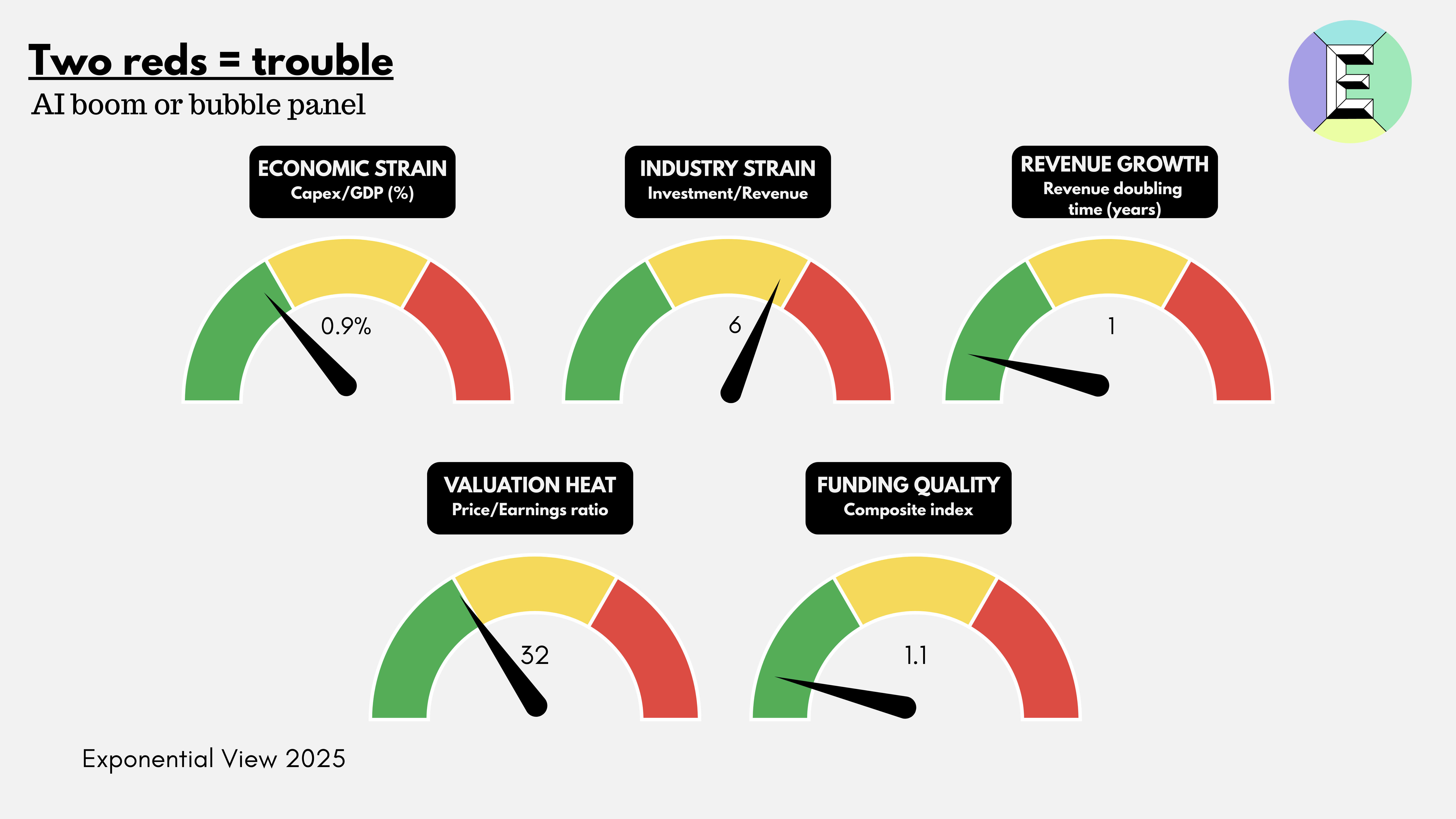In the electrifying rush of 2025, artificial intelligence has captivated the world like a digital gold rush, propelling tech giants to trillion-dollar valuations and igniting a frenzy of investments. Yet, as whispers turn to warnings from central banks and industry titans, the specter of an AI bubble bursting looms large. With AI-related capital expenditures surpassing U.S. consumer spending as the economy's primary growth driver in the first half of 2025—accounting for 1.1% of GDP— the stakes couldn't be higher. This isn't just a market hiccup; it's a potential seismic event that could ripple through global economies, upend investor portfolios, and force retailers to rethink their tech strategies.
Drawing parallels to the dot-com crash of 2000, where the Nasdaq plunged nearly 50% and trillions evaporated, today's AI hype—fueled by $359 billion in Big Tech capex and valuations detached from revenue realities—signals overexuberance. In this comprehensive analysis, we'll unpack what an AI bubble burst means, amplify expert voices, dissect its economic shockwaves, and arm investors and retailers with actionable strategies. As OpenAI's Sam Altman candidly admitted, "Some people are going to lose a phenomenal amount of money" when it pops. Buckle up—understanding this storm is your first line of defense.
What Does an AI Bubble Burst Mean in 2025?
An AI bubble, at its core, represents a speculative surge in asset prices driven by irrational exuberance around transformative technology, far outpacing fundamental value. Unlike sustainable growth, where revenues and productivity gains justify premiums, bubbles inflate on hype, leading to a sharp correction when reality intrudes. In 2025, AI investments have hit stratospheric levels: PitchBook reports nearly two-thirds of U.S. deal value in the first half flowed to AI and machine learning startups, up from 23% in 2023. Tech stocks, led by Nvidia's $4.5 trillion market cap, have surged, with the S&P 500's top 10 holdings (heavily AI-tilted) comprising over 40% of the index.
A burst would manifest as a "sudden correction," per the Bank of England, triggered by disappointing AI adoption, regulatory crackdowns, or energy constraints on data centers. Valuations are already frothy: AI firms trade at price-to-earnings ratios exceeding 500 (e.g., Palantir), compared to historical norms under 50. Revenue projections? OpenAI, despite $13 billion expected in 2025, faces $300 billion in Oracle commitments, underscoring the cash-burn reality.
Expert voices echo the alarm:
- Sam Altman (OpenAI CEO): "The artificial intelligence market is in a bubble, similar to the dotcom bubble."
- Jamie Dimon (JPMorgan CEO): "Fired up by optimism about the productivity-enhancing potential of AI, global equity prices are surging," but warns of a "sharp repricing."
- Kristalina Georgieva (IMF Managing Director): "The risk of a sudden correction could occur should expectations around the impact of AI become less optimistic."
These aren't doomsayers; they're architects of the boom spotting the cracks. The IMF and Bank of England have flagged "disappointing AI capability/adoption progress" as a key trigger, amplified by competition and geopolitical tensions. In essence, a burst means a painful recalibration: Overhyped startups fold, Big Tech retrenches, and the "AI gold rush" exposes fool's gold.
The Road to Rupture: Signs the Bubble is Inflating to Pop

Conceptual illustration of an AI bubble under scrutiny, with a robotic figure examining the fragile structure amid economic uncertainty.
Bubbles don't burst in isolation; they swell on telltale signs. In 2025, AI's momentum-driven market—where retail investors chase memes and hyperscalers like Microsoft and Nvidia loop investments in a "money machine"—mirrors the dot-com era's financial engineering. Key indicators:
- Insane Capex Black Hole: AI infrastructure spending hit $359 billion from Big Tech alone, representing 1% of U.S. GDP but driving 1.1% growth—yet profitability lags, with hyperscalers using SPVs to mask costs and inflate earnings.
- Valuation Disconnect: AI revenue is projected at $60 billion in 2025, but market caps eclipse trillions; the sector's P/E ratios dwarf historical peaks, with momentum (not fundamentals) fueling 40% of S&P gains.
- Hype vs. Reality Gap: Despite $1.5 trillion projected AI spending by 2025, adoption stalls—bots comprise 50% of internet traffic, but 20% are "bad bots" inflating metrics. Circular funding (Nvidia invests in OpenAI, which buys Nvidia chips) creates a self-reinforcing loop ripe for rupture.
As Derek Thompson notes, "The numbers just don't add up," with AI's economic warp—sucking capital from other sectors—setting the stage for a pop when productivity promises falter.
Economic Impacts: A Global Shockwave from Silicon Valley to Main Street
Historical graph of the dot-com bubble burst, illustrating Nasdaq decline and parallels to potential 2025 AI fallout.
If the AI bubble bursts, the fallout could dwarf the dot-com crash, where the S&P 500 shed 50% and telecom investments evaporated $2 trillion. AI's scale—1% of GDP in capex, versus telecom's smaller slice—amplifies risks: A correction could trigger a U.S. recession, with global spillovers via trade and finance.
- GDP Drag and Unemployment Spike: AI spending props up 1.1% of 2025 growth; a burst halts data center builds, idling construction jobs (millions affected) and slashing tech employment by 20-30%, per IMF models. The U.S. economy, already concentrated (top 10 stocks = 40% S&P), faces a "glitch in the matrix" with equity evaporation hitting pensions and 401(k)s.
- Inflation and Supply Chain Chaos: Surging energy demands from AI (equivalent to small countries' consumption) could spike prices if investments sour, exacerbating stagflation—U.S. slowdown + persistent inflation. Retailers reliant on AI logistics face disruptions, with global trade wars (e.g., Trump's tariffs) compounding the pain.
- Financial Contagion: A Nasdaq-like 50% drop could trigger credit crunches, as seen in 2000, but worse: AI's debt-fueled SPVs unwind, hitting banks and emerging markets via dollar asset repricing. The Economist warns of a $10 trillion U.S. economy goal by 2047 derailed, with spillovers to Europe and Asia.
In short, unlike dot-com's contained blast, AI's entwinement with infrastructure makes the pop a systemic threat, potentially shaving 2-3% off global GDP.
What Investors Should Do: Strategies to Weather the Storm

Gauge panel visualizing AI boom risks and investor strategies, highlighting valuation heat and funding quality in 2025.
Investors, don't panic—diversify. Morningstar advises broadening beyond the Magnificent Seven, as AI exuberance masks broader market risks. Key moves:
- Diversify Aggressively: Allocate 20-30% to non-tech sectors (e.g., renewables, commodities) and international equities; the top 10 S&P stocks' 40% weighting demands balance. ETFs like VTI (total market) hedge AI concentration.
- Focus on Fundamentals: Prioritize AI firms with real revenue (e.g., $60B projected sector-wide) over hype; use P/E under 30 as a filter, avoiding 500+ multiples. Tools like TrendSpider for backtesting AI strategies mitigate volatility.
- Hedge with Options and Bonds: Buy puts on QQQ (Nasdaq ETF) for downside protection; shift to Treasuries as Fed rates (potentially falling post-burst) offer yields.
- Long-Term Play: Echoing dot-com survivors (Amazon, Google), bet on proven innovators; Azeem Azhar notes, "AI isn't a bubble—the cash is real," but timing matters.
Paul Kedrosky warns: Sense the pop via rising short interest in AI stocks. Act now to preserve capital.
What Retailers Should Do: Safeguarding Operations Amid the Hype
Retailers, caught in AI's crosshairs, must adopt judiciously. The bubble's burst could hike costs (e.g., cloud fees from retreating hyperscalers) while disrupting supply chains reliant on AI logistics.
- Pilot, Don't Plunge: Test AI tools (e.g., inventory prediction) on small scales; avoid $60B-scale commitments like OpenAI's, focusing on ROI-proven apps.
- Diversify Vendors: Partner beyond Big Tech (e.g., open-source LLMs via Hugging Face) to evade lock-in; build hybrid systems blending AI with legacy ERP.
- Stress-Test Supply Chains: Model bubble scenarios using tools like AWS Forecast; stockpile buffers for energy/inflation spikes.
- Invest in People: Upskill staff for AI oversight; as adoption lags, human-AI hybrids yield 15-20% efficiency gains without bubble risks.
The Guardian's Phillip Inman advises: "AI isn’t going away, crash or no crash"—use the dip to acquire tech cheaply.
Conclusion: From Bubble to Breakthrough – The Silver Lining
The AI bubble's potential burst in 2025 isn't the end of innovation—it's a reset, much like dot-com's purge birthed Amazon and Google. With $33.9 billion in GenAI investments already committed, the tech endures, but prudence prevails. Investors: Diversify and fundamentals-first. Retailers: Pilot and partner wisely. Economies: Brace for shocks, but emerge stronger.
As Al Jazeera posits, "If that bubble were to burst, it could do a lot of damage to the U.S. economy—but AI will transform it nonetheless." At Aidea Solutions, we're here to navigate this—contact us for resilient AI strategies. The rush is real; the burst, avoidable.
The AI Bubble Burst: Warnings, Impacts, and Survival Strategies for 2025